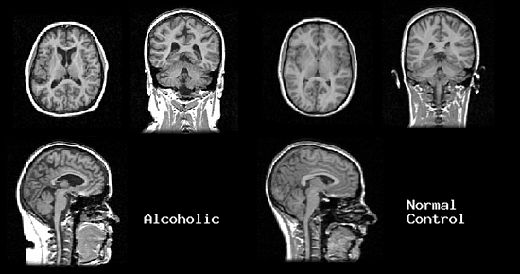Alcohol Education A-2

Your Brain and Nerves: Heavy to excessive amounts of alcohol(ethanol) can hurt the brain and your body nerves.
Ethanol is a potent central nervous system depressant, with a range of side effects. Initially, alcohol generally produces feelings of relaxation and cheerfulness, but further consumption can lead to blurred vision and coordination problems. Cell membranes are highly permeable to alcohol, so once alcohol is in the bloodstream it can diffuse into nearly every biological tissue of the body. After excessive drinking, unconsciousness can occur and extreme levels of consumption can lead to alcohol poisoning and death (a concentration in the blood stream of .40% will kill half of those affected. Death can occur through asphyxiation by vomit.
Blood Brain Barrier: The brain can block small amounts of alcohol from getting to it. Several drinks can break this barrier. When this happens, the brain cells may be damaged.
Drinking in moderation is defined as never consuming more than 2 servings of-
Picture A: Images displayed in the coronal orientation from MRI and DTI studies of a 61 year old healthy man (upper images) and a 60 year old alcoholic man(lower images). The high resolution MRI slices are at the same locations as the fractional anisotropy images of the DTI panels. Note on the MRI the thinner corpus collosum displaced upward by enlarged ventricles and on the DTI less well delineated white matter tracts in the alcoholic man compared with the healthy man. Source: Rosenbloom, M. Sullivan, E.V., and Pfeffebaum A. Using magnetic resonance imaging and diffusion tensor imaging to assess brain damage in alcoholics. Alcohol Research & Health 27(2): 2003
alcohol in a 24-hour period (1 serving=One 12 oz. beer or 1 oz. shot of hard alcohol (80 proof/40%alcohol).
- Excessive drinking can greatly reduce mental power, damage memory, ability to learn new ideas or even the ability to think of new ways to do things.
- Heavy drinking can damage nerve cells in all parts of the body, noted by tingling of the fingers and feet, weakness of the muscles or numbness.
- Some experts say that brain cells are damaged by the presence of any alcohol in the brain.
Resource: Driving With Care Handbook and www.niaaa.nih.gov/

Ethanol is the specific chemical name of the alcohol that is found beer, whine and all types of hard alcohol such as whiskey, vodka and tequila. Ethanol is a Central Nervous System (CNS) depressant drug. Ethanol is commonly used as a recreational drug as it is the only consumable alcohol by humans. Ethanol is also found in mouthwash, some medications is an important gasoline additive and used to-
Image B: Comparison of two female subjects who had volumetric MRIs created in a GE 1.5 Tesla MRI Machine. This illustration is from NIAAA's Laboratory of Clinical Studies, section of Brain Electrophysiology and Imaging. The image on the left illustrates a damaged brain (corpus collosum) and cerebral cortex due to the effects of alcohol consumption when compared to the control non drinking subject.
power vehicles in some countries. Other types of alcohol such as Isopropyl alcohol (rubbing alcohol) are twice as toxic as ethanol but still considered a CNS depressant. Uses for isopropyl alcohol include cleaning products as well as disinfectants. Methanol is the other commonly used alcohol. Methanol is a common ingredient in antifreeze, paints and solvents.
What happens when you drink? Alcohol depresses the nerves that control involuntary actions such as breathing, heartbeat and you gag reflex, which keeps you from chocking. Excessive alcohol intake can slow and in some cases shut down these functions. Your body temperature can also drop(hypothermia), leading to cardiac arrest. Blood sugar can also fall low enough to cause seizures.
One researched characteristic and hypothesis is that alcoholism accelerates aging. Brains of alcoholics resemble brains of chronologically old nonalcoholics. This may occur at the onset of problem drinking ("accelerated aging") or later in life when brains are more vulnerable ("increased vulnerability" or "cumulative effects").  Brain Activity During Alcohol Intoxication
Brain Activity During Alcohol Intoxication
Overview of Neurological Effects of Alcohol: About half of the nearly 20 million alcoholics in the United States seem to be free of cognitive impairments. In the remaining half, however, neuropsychological difficulties can range from mild to severe. For example, up to 2 million alcoholics develop permanent and debilitating conditions that require lifetime custodial care(Rourke and Loberg 1996). Examples of such conditions include alcohol-induced persisting amnesic disorder (also called Wernicke-Korsakoff syndrome) and dementia, which seriously affects many mental-
Image C: Alcohol drinking markedly reduces brain metabolism. The image on the above illustrates brain activity at different levels of brain functioning.
functions in addition to memory (e.g. language, reasoning and problem solving abilities). Most alcoholics with neuropsychological impairments show at least some improvement in brain structure and functioning within a year of abstinence, but some people take much longer (Bates et al 2002, Sullivan et al. 2000)
Research of the Neurons and Brain is Still Largely a Mistery: Unfortunately, little is known about the rate and extent to which people recover specific structural and functional processes after they stop drinking. However, research has helped define the various factors that influence a person's risk for experiencing alcoholism-related brain deficits, as the following sections describe. The brain is the least understood organ in the body due to the complexity of neurons and of human thinking and intelligence.
Resource: pubs.niaaa.nih.gov/publications/arh27-2/125-133.htm
